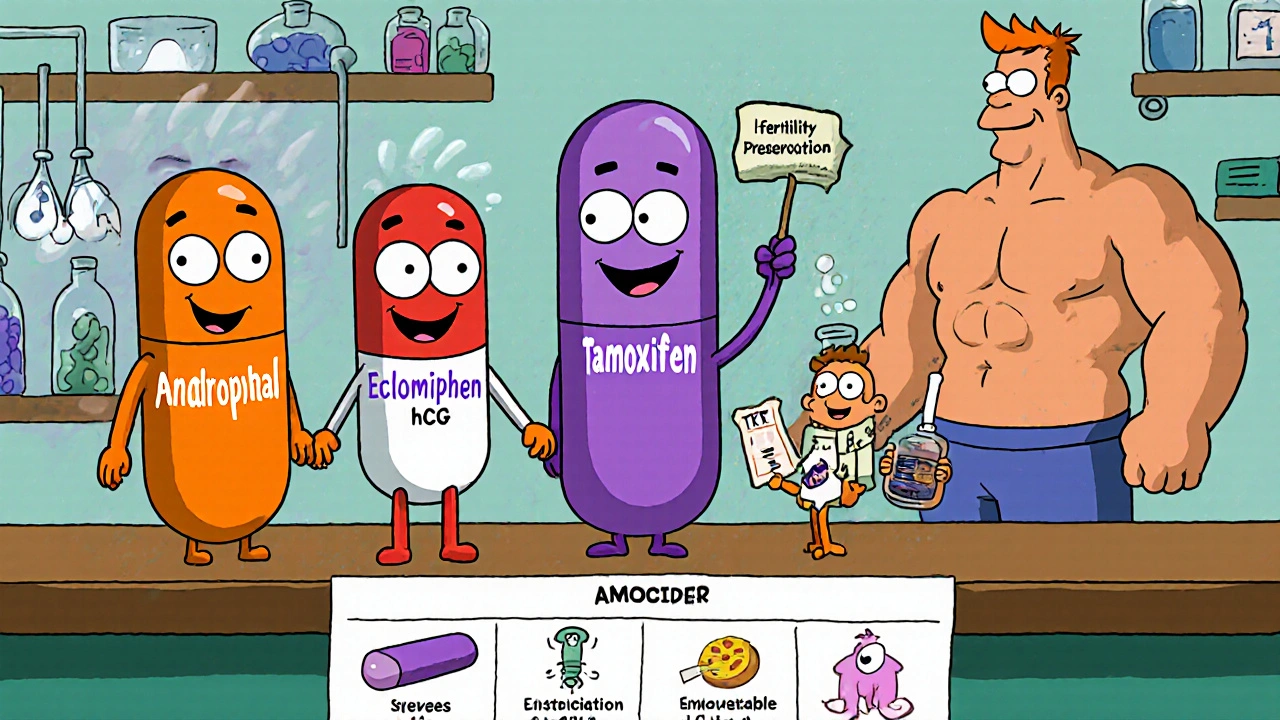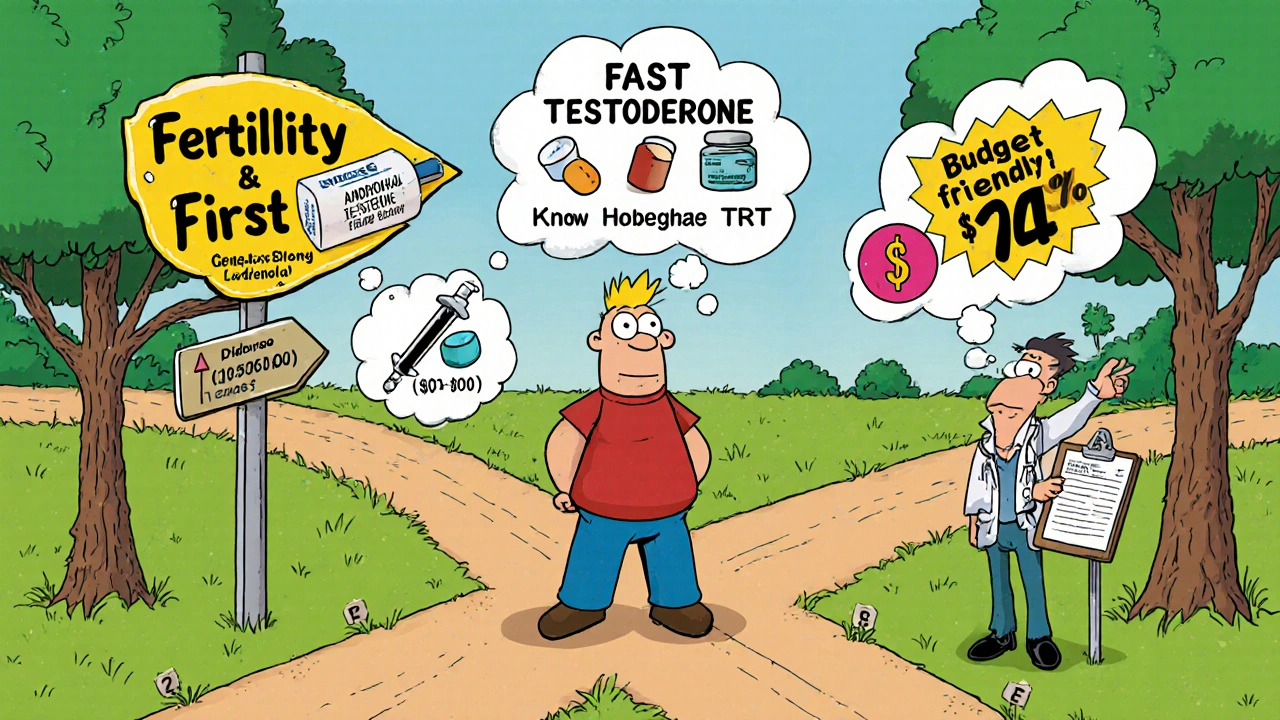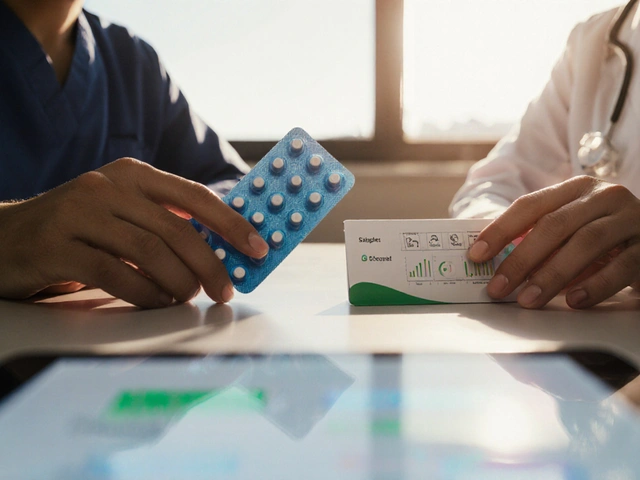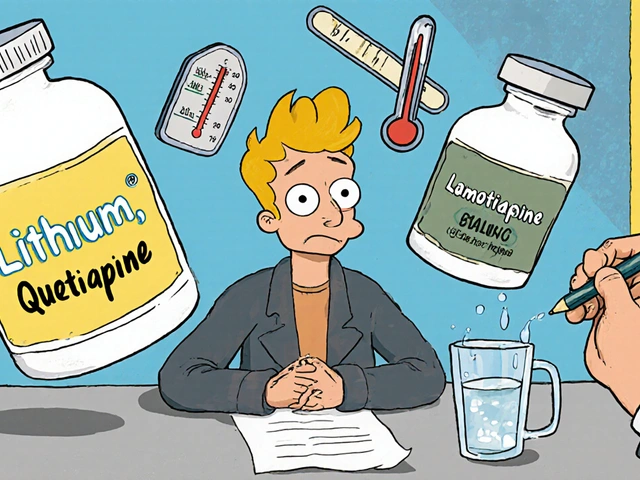
Testosterone Treatment Comparison Tool
Select your top priority to see which testosterone treatment best matches your needs:
Recommended Treatment
Note: Always consult with a healthcare provider before making treatment decisions.
When men struggle with low testosterone, the market is flooded with pills, gels, and injections. Androxal has been marketed as a non‑injectable way to nudge the body’s own testosterone factory back into gear. But how does it really stack up against other options like clomiphene, tamoxifen, or even classic testosterone replacement therapy (TRT)? This guide breaks down the science, dosing, safety, and real‑world experience so you can decide which route fits your goals.
Androxal is the brand name for enclomiphene citrate, a selective estrogen receptor modulator (SERM) that blocks estrogen’s feedback on the hypothalamus‑pituitary axis, leading to a rise in luteinizing hormone (LH) and follicle‑stimulating hormone (FSH). The hormone surge tells the testes to crank out more testosterone on their own.
What is Enclomiphene and How Does It Work?
- Enclomiphene is the trans‑isomer of clomiphene citrate, isolated for its more potent anti‑estrogenic effect.
- By occupying estrogen receptors in the hypothalamus, it prevents estrogen from delivering the “enough” signal.
- Result: the pituitary releases more LH and FSH, which stimulate Leydig cells to produce testosterone.
- The rise is endogenous, so sperm production usually stays intact, a key advantage over exogenous TRT.
Why Some Men Prefer a SERM Over Direct Testosterone
Direct testosterone (injections, gels, patches) floods the bloodstream, often suppressing the body's own production. That suppression can shrink testicular size and lower fertility. Enclomiphene aims to keep the testicular axis active, preserving sperm output while still boosting serum testosterone. For men who want to maintain fertility or avoid the hassle of injections, a SERM can feel like a sweet spot.
Key Alternatives to Androxal
Below are the most common drugs that people compare against enclomiphene:
- Clomiphene citrate - the older, racemic mixture of enclomiphene (trans) and zuclomiphene (cis). Used off‑label for male hypogonadism.
- Tamoxifen - another SERM, primarily for breast cancer, sometimes used to raise testosterone.
- Human chorionic gonadotropin (hCG) - mimics LH, directly stimulating Leydig cells.
- Anastrozole - an aromatase inhibitor that lowers estrogen conversion, indirectly raising testosterone.
- Testosterone replacement therapy (TRT) - injectable or transdermal testosterone formulations.
Side‑Effect Profiles at a Glance
All drugs have trade‑offs. Here’s a quick look at what patients typically report.
| Drug | Common Side‑Effects | Rare but Serious | Impact on Fertility |
|---|---|---|---|
| Androxal (Enclomiphene) | Headache, mild nausea, hot flashes | Visual disturbances, retinal changes (very rare) | Neutral to positive - maintains sperm |
| Clomiphene citrate | Visual spots, mood swings, gynecomastia | Retinal toxicity, hepatic strain | Generally preserves sperm, but higher dose may affect quality |
| Tamoxifen | Nausea, fatigue, hot flashes | Deep‑vein thrombosis, liver enzyme elevation | Usually preserves sperm |
| hCG | Injection site pain, acne | Gynecomastia, estrogen surge | Boosts sperm output when combined with FSH |
| Anastrozole | Joint pain, fatigue | Bone density loss with long‑term use | Neutral - does not suppress sperm |
| TRT (injectable) | Injection pain, acne | Polycythemia, cardiovascular risk, testicular atrophy | Suppresses endogenous production - can lower sperm |

Dosage and Administration Differences
- Androxal: 12.5 mg - 25 mg once daily, typically taken in the morning with food.
- Clomiphene citrate: 25 mg - 50 mg daily, sometimes cycled (e.g., 3 weeks on, 1 week off).
- Tamoxifen: 10 mg - 20 mg daily, taken with meals to reduce nausea.
- hCG: 1,000 IU subcutaneously 2-3 times per week, often combined with oral SERMs.
- Anastrozole: 0.5 mg - 1 mg daily, taken at night.
- TRT injections: 100 mg - 200 mg intramuscularly every 1-2 weeks, or weekly if using a smaller dose.
The oral SERMs (Androxal, clomiphene, tamoxifen) win on convenience, while hCG and TRT require injections. Convenience matters if you travel often or dislike needles.
Regulatory Status and Availability (2025)
Androxal was approved by the FDA in 2020 for “secondary hypogonadism” but has faced manufacturing delays, making it scarce in many U.S. pharmacies. Some compounding pharmacies still offer it under a specialty label. Clomiphene and tamoxifen are both FDA‑approved for other indications (infertility, breast cancer) and are readily available off‑label. hCG is FDA‑approved for infertility, and anastrozole is approved for breast cancer, both sold widely. TRT is a Schedule III prescription drug with broad insurance coverage.
Cost Comparison (U.S. Prices in 2025)
- Androxal: $120‑$150 for a 30‑day supply (premium brand).
- Clomiphene: $30‑$50 for 30 tablets (generic).
- Tamoxifen: $40‑$60 for 30 tablets (generic).
- hCG: $70‑$100 per 5,000 IU vial (requires refrigeration).
- Anastrozole: $25‑$35 for 30 tablets (generic).
- TRT: $200‑$300 per month for injectables, not counting labs.
For men on a tight budget, the cheaper SERMs or aromatase inhibitor often make sense, but you have to weigh efficacy.
Real‑World Outcomes: What Do Patients Say?
Clinical trials for enclomiphene showed a mean serum testosterone increase of 300 ng/dL after 12 weeks, with maintained sperm counts around 50‑70 million/mL. In a 2023 post‑marketing survey of 1,200 men, 68 % reported improved energy and libido, while only 4 % stopped due to side‑effects.
Comparatively, clomiphene users in a 2022 registry achieved similar testosterone gains (~250 ng/dL) but reported a higher rate of visual disturbances (≈8 %). Tamoxifen’s data is scarcer for men; a small 2021 case series noted modest testosterone rises but a notable 6 % incidence of mild thrombosis.
hCG combined with an oral SERM often produces the most robust fertility boost, but costs can climb above $200 a month.

Choosing the Right Approach for You
Use the quick decision guide below to match your personal priorities with the drug that fits best.
- Goal: Preserve or improve fertility - Choose Androxal, clomiphene, or hCG‑SERM combo.
- Goal: Fastest rise in testosterone - TRT gives the biggest spike, but expect fertility suppression.
- Goal: Minimal injections - Oral SERMs (Androxal, clomiphene, tamoxifen) win.
- Goal: Lowest cost - Generic clomiphene or anastrozole are cheapest.
- Goal: Avoid estrogen‑related side‑effects - Androxal’s selective action may cause fewer hot flashes than tamoxifen.
Potential Pitfalls and How to Avoid Them
1. No baseline labs - Always get a full hormone panel (total testosterone, free testosterone, LH, FSH, estradiol, PSA) before starting.
2. Self‑adjusting dose - Titrate under physician guidance; jumping from 12.5 mg to 50 mg of Androxal can cause headache storms.
3. Skipping follow‑up - Re‑check labs every 4‑6 weeks; unexpected estrogen rise may need an aromatase inhibitor.
4. Ignoring drug interactions - SERMs can affect warfarin metabolism; inform your doctor if you’re on blood thinners.
Summary of Key Differences
| Aspect | Androxal (Enclomiphene) | Clomiphene Citrate | Tamoxifen | hCG + SERM | TRT |
|---|---|---|---|---|---|
| Mechanism | Selective estrogen blockade → ↑ LH/FSH | Mixed isoforms, similar block | Estrogen antagonist in breast tissue & hypothalamus | Direct LH mimic + oral SERM | Exogenous testosterone |
| Oral/Injectable | Oral | Oral | Oral | Injectable + oral | Injectable / gel |
| Fertility Impact | Preserves | Preserves (dose‑dependent) | Preserves | Enhances | Suppresses |
| Typical Cost (30 days) | $120‑$150 | $30‑$50 | $40‑$60 | $200‑$250 | $200‑$300 |
| Common Side‑Effects | Headache, hot flashes | Visual spots, mood swings | Nausea, fatigue | Injection pain, acne | Acne, polycythemia |
Next Steps: How to Start Safely
- Schedule a visit with an endocrinologist or a urologist experienced in male hormone health.
- Request a baseline hormone panel (total T, free T, LH, FSH, estradiol, SHBG, PSA).
- Discuss your goals (energy, libido, fertility) and any budget constraints.
- If Androxal is chosen, begin with 12.5 mg daily and repeat labs in 4‑6 weeks.
- Adjust dose based on lab results and symptom feedback; keep a symptom diary.
- Plan regular follow‑up every 3‑6 months for long‑term safety.
The right choice isn’t one‑size‑fits‑all. By weighing mechanism, cost, side‑effects, and fertility impact, you can pick the path that aligns with your health goals.
Can women take Androxal for hormone issues?
Androxal is specifically studied for male secondary hypogonadism. There is limited data on female use, and off‑label prescribing is not recommended without specialist supervision.
How long does it take to see results?
Most men notice improved energy and libido within 4‑6 weeks, while lab‑confirmed testosterone rises typically appear after 8‑12 weeks of consistent dosing.
Is Androxal safe for long‑term use?
Long‑term safety data is still emerging. Current studies up to 2 years show a stable side‑effect profile, but regular monitoring of liver enzymes, lipids, and eye exams is advised.
Can I combine Androxal with an aromatase inhibitor?
Yes, some clinicians add a low‑dose aromatase inhibitor (e.g., anastrozole 0.5 mg) if estradiol rises above 40 pg/mL. This combo can fine‑tune hormone balance, but it must be supervised to avoid overly low estrogen.
What monitoring schedule is recommended?
Initial labs before starting, then repeat at 4‑6 weeks, 12 weeks, and every 3-6 months thereafter. Include testosterone, LH, FSH, estradiol, CBC, liver panel, and PSA (if over 40).




sara fanisha
October 23, 2025Great rundown, really helpful!
Tristram Torres
October 23, 2025Honestly, this whole SERM hype feels like a band‑aid that never fixes the deeper issue. The article glosses over the fact that many men end up cycling on and off these pills without real supervision. You’re basically trading one set of side‑effects for another, and the long‑term data is practically non‑existent. Plus, the price tag on Androxal makes it a luxury product for those who can afford it, which isn’t exactly a solution for the average guy. The convenience of a pill is nice, but you still need regular labs and a doctor who actually knows what they’re doing. Otherwise, you risk hormonal chaos that could have been avoided with proper TRT dosing. In short, the so‑called “non‑injectable” route isn’t a free pass to ignore medical oversight.
Jinny Shin
October 23, 2025When one delves into the labyrinth of hormonal manipulation, the stakes rise far beyond a simple boost in libido.
The narrative presented, while thorough, glosses over the sociocultural ramifications of normalizing pharmacological testosterone elevation.
One must ask whether the allure of a convenient oral capsule masks the deeper ethical quandary of commodifying masculinity.
Moreover, the selective estrogen receptor modulation offered by enclomiphene is not a panacea; subtle endocrine feedback loops can be perturbed in unpredictable ways.
The literature, though promising, is still nascent, and long‑term surveillance data remain scant.
Patients, especially those with pre‑existing cardiovascular risk, may inadvertently invite complications that surface only after years of exposure.
In parallel, the economic barrier erected by premium pricing creates a divide, privileging those with disposable income.
Such disparity fuels a clandestine market where black‑market analogs proliferate, compounding safety concerns.
Furthermore, the comparison to hCG and TRT neglects the nuanced psychological impact of shifting from endogenous to exogenous hormone sources.
The psychological dependency on a daily tablet can be as insidious as the physical side‑effects.
Physicians, tasked with navigating these murky waters, must balance empirical evidence with patient autonomy.
The current regulatory framework, while stringent, still permits off‑label use that can outpace the guidelines.
An interdisciplinary approach, integrating endocrinology, urology, and mental health, would provide a more holistic assessment.
Until such a paradigm shift materializes, any recommendation remains provisional at best.
Thus, the discourse should pivot from mere efficacy tables to a broader conversation about responsibility, equity, and the long‑term stewardship of male health.
deepak tanwar
October 23, 2025From a strictly clinical perspective, the pharmacodynamics of enclomiphene are indeed fascinating, yet the data set remains limited to relatively short‑term trials. While the endogenous testosterone surge is advantageous for preserving spermatogenesis, clinicians must remain vigilant regarding potential estrogen rebound phenomena. Moreover, the scarcity of Androxal in many pharmacies raises questions about the practicality of prescribing a drug with intermittent availability. It would be prudent to compare the cost‑effectiveness of generic clomiphene, which offers a similar mechanism at a fraction of the price. Lastly, any hormonal intervention warrants a structured monitoring protocol to preempt adverse events.
Abhishek Kumar
October 23, 2025The monitoring schedule you mention is spot on.
I’d add that checking liver enzymes every few months is also wise.
hema khatri
October 23, 2025Guys, let’s not forget that many of us in India struggle to get any of these drugs legally, let alone a pricey brand like Androxal.
The local market is flooded with sub‑standard copies, and that’s a huge risk for our health.
If you’re thinking about trying SERM therapy, make sure you source it from a reputable pharmacy or a licensed doctor.
Otherwise you could be shooting yourself in the foot with unknown contaminants.
Stay safe and always double‑check the authenticity before buying.
Jennell Vandermolen
October 23, 2025Excellent reminder about sourcing, thank you!
It’s always best to verify with a qualified clinician first.
If you’re unsure, many telehealth services can help prescribe safely.
Keep a journal of any symptoms; it helps your doctor adjust the plan quickly.
Stay healthy and take care.
Mike Peuerböck
October 23, 2025Allow me to synthesize the key take‑aways for anyone navigating this therapeutic maze.
First, oral SERMs like Androxal offer the allure of convenience while preserving endogenous sperm output, a distinct advantage over traditional TRT.
Second, the financial calculus cannot be ignored; generic clomiphene delivers comparable biochemical shifts at a fraction of the cost.
Third, safety remains paramount – regular labs, especially estradiol and liver panels, are non‑negotiable.
Fourth, patient goals dictate the optimal path: fertility preservation leans toward SERMs or hCG‑SERM combos, whereas rapid symptom relief may favor TRT.
Fifth, regulatory landscapes differ worldwide, so access and legal considerations must be factored into any decision.
In practice, a stepwise approach-baseline labs, trial of low‑dose SERM, reassessment, then escalation if needed-offers a balanced strategy.
Ultimately, informed shared decision‑making with a knowledgeable clinician is the cornerstone of safe, effective hormone optimization.
Simon Waters
October 24, 2025Remember, big pharma pushes these pills to keep us hooked on their profit machines.